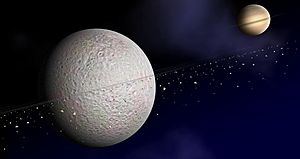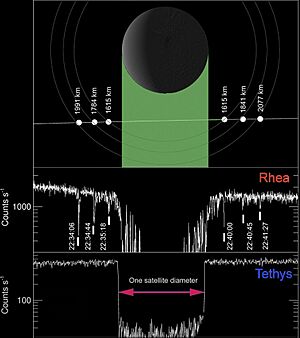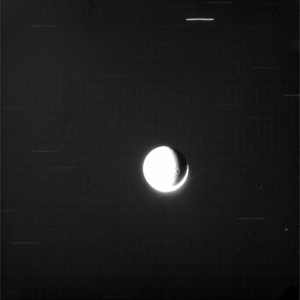Rings of Rhea facts for kids
The Saturnian moon Rhea might have a thin ring system with three narrow bands. These bands would be made of solid particles. If confirmed, these would be the first rings ever seen around a moon. Scientists announced this exciting discovery in the journal Science on March 6, 2008.
In November 2005, the Cassini spacecraft found something unusual near Rhea. Saturn's magnetosphere (the area around Saturn controlled by its magnetic field) seemed to be missing some energetic electrons close to Rhea. The team that found this believes the best explanation is that these electrons were absorbed. They think solid material, like a disk of particles, might be orbiting Rhea. This disk could have denser rings or arcs within it, with particles possibly ranging from a few decimeters (about a foot) to a meter (about three feet) in size.
Contents
How Were Rhea's Rings Discovered?
Even back in 1980, the Voyager 1 spacecraft noticed something similar. It found an area with fewer energetic electrons in Saturn's magnetic field after passing Rhea. These measurements were never fully explained at the time. Voyager 1's observations were made from farther away than the Cassini data.
Cassini's Close Flyby of Rhea
On November 26, 2005, Cassini made its closest flyby of Rhea during its main mission. It flew only 500 kilometers (about 310 miles) above Rhea's surface. As Cassini passed, it entered Rhea's "plasma wake." This is like a shadow in the plasma (charged particles) that flows from Saturn's magnetic field.
When Cassini flew past other moons, like Dione and Tethys, it saw a clear drop in energetic electrons. This happened as Cassini entered the moons' plasma shadows, where the moons blocked the plasma.
However, with Rhea, the electron plasma started to drop off much earlier. This gradual decrease began at about eight times Rhea's radius. It continued until Cassini entered Rhea's actual plasma shadow, where a sharp drop occurred. This extended distance matches Rhea's Hill sphere. The Hill sphere is the area around a moon where its own gravity is stronger than the planet's gravity. For Rhea, this is about 7.7 times its radius. When Cassini left Rhea's plasma shadow, the opposite happened: a sharp increase in electrons, then a gradual rise back to normal levels.
Comparing Rhea to Enceladus
These readings are similar to what was seen at Enceladus. At Enceladus, water plumes shooting out from its south pole absorb the electron plasma. But for Rhea, the absorption pattern is symmetrical, meaning it's the same on both sides.
The Magnetospheric Imaging Instrument (MIMI) on Cassini also saw something important. This gradual change in plasma flow had three sharp drops on each side of Rhea. This pattern was also almost perfectly symmetrical.
In August 2007, Cassini flew through Rhea's plasma shadow again, but farther away. Its readings were similar to those from Voyager 1.
Why Are There No Pictures of the Rings?
So far, there are no direct images or sightings of the material that is thought to be absorbing the plasma. This is because the likely candidates for these rings would be very hard to see directly. Scientists planned more observations during Cassini's mission extension. A close flyby was scheduled for March 2, 2010, to gather more information.
How Did Rhea's Rings Form?
Scientists have run computer simulations that suggest solid objects can orbit Rhea stably. These orbits would be near Rhea's equator and could last for very long periods of time. Such rings might not be stable around moons like Dione and Tethys. This is because those moons are much closer to Saturn, so their Hill spheres are smaller. Rings might also not be stable around Titan because of the thick atmosphere that would create drag.
Many ideas have been suggested for how these rings might have formed.
- One idea is that an impact could have sent material into orbit around Rhea. This might have happened as recently as 70 million years ago.
- Another idea is that a small space object could have been broken apart when it got caught in orbit around Rhea.
In either case, the broken pieces would eventually settle into circular orbits around Rhea's equator. However, because these rings could be stable for so long, it's also possible they have been there since Rhea itself first formed.
For different rings to exist, something must keep them separate. Scientists suggest that small moonlets or clumps of material within the disk could act like "shepherds." These would be similar to the moonlets seen within Saturn's A ring.
Images for kids






